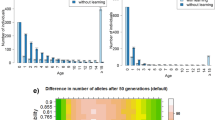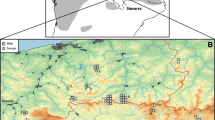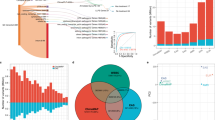Abstract
A model for the genetic identity between diploid sexual populations is presented that considers simultaneously mutation and genetic drift as affecting gene frequencies. In contrast to other measures of genetic identity the proposed model allows the genetic identity to be estimated directly from a data set. The new model is integrated into the existing body of population genetics theory. For an infinite population size the model becomes identical to the pure mutation model and if mutation is neglected, it becomes equal to the well-known drift model. The proposed measure of genetic identity between a population and its ancestral population is independent of the population size and equal to the number of ancestral alleles found in the present population. Using data on protein variability from ten primate species, it is shown that the estimate of genetic identity proposed here correlates closely with other identity measures that do not consider genetic drift. The conclusions from hitherto existing studies on the genetic similarity of species, therefore, seem to be reliable. Finally, implications for estimates of the ancestral degree of homozygosity are discussed.
Similar content being viewed by others
Article PDF
References
Cavalli-Sforza, L L, and Edwards, A W F. 1967. Phylogenetic analysis: models and estimation procedures. Am J Hum Genet, 19, 233–257.
Crozier, R H, and Kusmierski, R M. 1994. Genetic distances and the setting of conservation priorities. In: Loeschcke, V., Tomiuk, J. and Jain, S. K. (eds) Conservation Genetics, pp. 227–238. Birkhäuser Verlag, Basel.
Fisher, R A. 1930. The Genetical Theory of Natural Selection. Clarendon Press, Oxford.
Hartl, D L, and Clark, A G. 1989. Principles of Population Genetics. Sinauer, Sunderland, MA.
Hillis, D M. 1984. Misuse and modification of Nei's genetic distance. Syst Zool, 33, 238–240.
Nei, M. 1972. Genetic distance between populations. Am Nat, 106, 283–292.
Nozawa, K, Shotake, T, Ohkura, Y, and Tanabe, Y. 1977. Genetic variations within and between species of Asian macaques. Jap J Genet, 52, 15–30.
Reynolds, J, Weir, B S, and Cockerham, C C. 1983. Estimation of the coancestry coefficient: basis for a short-term genetic distance. Genetics, 105, 767–779.
Schmitt, J, Graur, D, and Tomiuk, J. 1990. Phylogenetic relationships and rates of evolution in primates: allozymic data from Catarrhine and Platyrrhine species. Primates, 31, 95–108.
Tomiuk, J, and Graur, D. 1988. Nei's modified identity and distance measure and their sampling variances. Syst Zool, 37, 156–162.
Tomiuk, J, and Loeschcke, V. 1991. A new measure of genetic identity between populations of sexual and asexual species. Evolution, 45, 1685–1694.
Tomiuk, J, and Loeschcke, V. 1992. Evolution of parthenogenesis in the Otiorhynchus scaber complex. Heredity, 68, 391–397.
Vane-Wright, R I, Humphries, C J, and Williams, P H. 1991. What to protect? - Systematics and the agony of choice. Biol Conserv, 55, 235–254.
Witting, L, McCarthy, M A, and Loeschcke, V. 1994. Multi-species risk analysis, species evaluation, and biodiversity conservation. In: Loeschcke, V., Tomiuk, J. and Jain, S. K. (eds) Conservation Genetics, pp. 239–251. Birkhäuser Verlag, Basel.
Wright, S. 1931. Evolution in Mendelian populations. Genetics, 16, 97–159.
Author information
Authors and Affiliations
Rights and permissions
About this article
Cite this article
Tomiuk, J., Loeschcke, V. Genetic identity combining mutation and drift. Heredity 74, 607–615 (1995). https://doi.org/10.1038/hdy.1995.84
Received:
Issue date:
DOI: https://doi.org/10.1038/hdy.1995.84
Keywords
This article is cited by
-
Genetic diversity of Ovis aries populations near domestication centers and in the New World
Genetica (2011)
-
Genetic diversity and evolutionary relationships ofOryza species with the B- and C-genomes as revealed by SSR markers
Journal of Plant Biology (2006)
-
Population structure and host-plant specialization in two Scaptodrosophila flower-breeding species
Heredity (2005)
-
A hierarchical analysis of genetic structure and variability in patchily distributed coexisting Chiastocheta species (Diptera: Anthomyiidae)
Heredity (1996)



